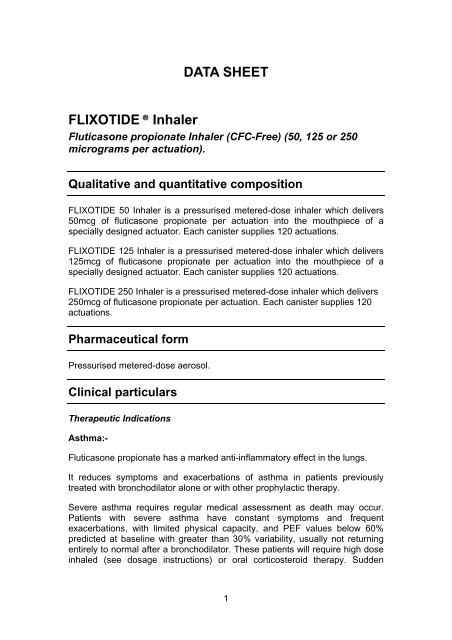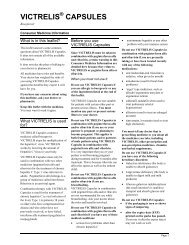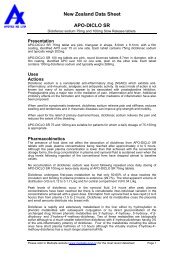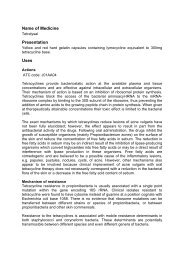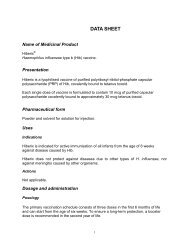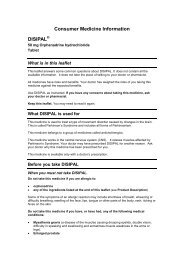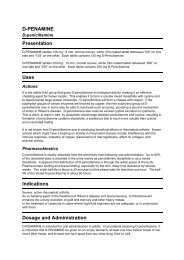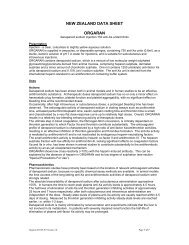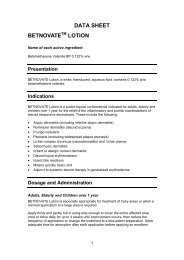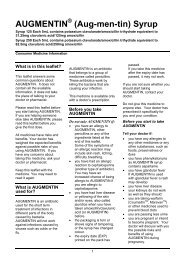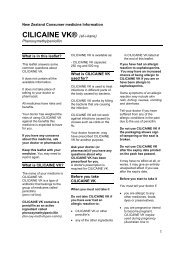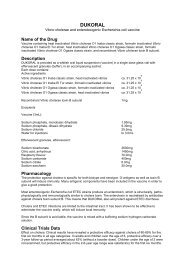FLIXOTIDE Inhaler (CFC-Free) - Medsafe
FLIXOTIDE Inhaler (CFC-Free) - Medsafe
FLIXOTIDE Inhaler (CFC-Free) - Medsafe
Create successful ePaper yourself
Turn your PDF publications into a flip-book with our unique Google optimized e-Paper software.
<strong>FLIXOTIDE</strong> ® <strong>Inhaler</strong><br />
DATA SHEET<br />
Fluticasone propionate <strong>Inhaler</strong> (<strong>CFC</strong>-<strong>Free</strong>) (50, 125 or 250<br />
micrograms per actuation).<br />
Qualitative and quantitative composition<br />
<strong>FLIXOTIDE</strong> 50 <strong>Inhaler</strong> is a pressurised metered-dose inhaler which delivers<br />
50mcg of fluticasone propionate per actuation into the mouthpiece of a<br />
specially designed actuator. Each canister supplies 120 actuations.<br />
<strong>FLIXOTIDE</strong> 125 <strong>Inhaler</strong> is a pressurised metered-dose inhaler which delivers<br />
125mcg of fluticasone propionate per actuation into the mouthpiece of a<br />
specially designed actuator. Each canister supplies 120 actuations.<br />
<strong>FLIXOTIDE</strong> 250 <strong>Inhaler</strong> is a pressurised metered-dose inhaler which delivers<br />
250mcg of fluticasone propionate per actuation. Each canister supplies 120<br />
actuations.<br />
Pharmaceutical form<br />
Pressurised metered-dose aerosol.<br />
Clinical particulars<br />
Therapeutic Indications<br />
Asthma:-<br />
Fluticasone propionate has a marked anti-inflammatory effect in the lungs.<br />
It reduces symptoms and exacerbations of asthma in patients previously<br />
treated with bronchodilator alone or with other prophylactic therapy.<br />
Severe asthma requires regular medical assessment as death may occur.<br />
Patients with severe asthma have constant symptoms and frequent<br />
exacerbations, with limited physical capacity, and PEF values below 60%<br />
predicted at baseline with greater than 30% variability, usually not returning<br />
entirely to normal after a bronchodilator. These patients will require high dose<br />
inhaled (see dosage instructions) or oral corticosteroid therapy. Sudden<br />
1
worsening of symptoms may require increased corticosteroid dosage which<br />
should be administered under urgent medical supervision.<br />
Adults:-<br />
Prophylactic management in:-.<br />
- Mild asthma (PEF values greater than 80% predicted at baseline with less<br />
than 20% variability): Patients requiring intermittent symptomatic<br />
bronchodilator asthma medication on more than an occasional basis.<br />
- Moderate asthma (PEF values 60-80% predicted at baseline with 20-30%<br />
variability): Patients requiring regular asthma medication and patients with<br />
unstable or worsening asthma on currently available prophylactic therapy<br />
or bronchodilator alone.<br />
- Severe asthma (PEF values less than 60% predicted at baseline with<br />
greater than 30% variability): Patients with severe chronic asthma. On<br />
introduction of inhaled fluticasone propionate many patients who are<br />
dependent on systemic corticosteroids for adequate control of symptoms<br />
may be able to reduce significantly or to eliminate their requirement for oral<br />
corticosteroids.<br />
Children:-<br />
Any child who requires preventive asthma medication, including patients not<br />
controlled on currently available prophylactic medication.<br />
Posology and Method of Administration<br />
<strong>FLIXOTIDE</strong> <strong>Inhaler</strong> (<strong>CFC</strong>-<strong>Free</strong>) is for oral inhalation only.<br />
The diagnosis and treatment of asthma should be kept under regular review.<br />
Patients should be made aware of the prophylactic nature of therapy with<br />
inhaled fluticasone propionate and that it should be taken regularly even when<br />
they are asymptomatic. The onset of therapeutic effect is 4 to 7 days,<br />
although some benefit may be apparent as soon as 24 hours for patients who<br />
have not previously received inhaled steroids.<br />
The dosage of fluticasone propionate should be adjusted according to the<br />
individual response.<br />
If patients find that relief with short-acting bronchodilator treatment becomes<br />
less effective or they need more inhalations than usual, medical attention<br />
must be sought.<br />
It is intended that each prescribed dose is given by a minimum of 2<br />
inhalations.<br />
In patients who find co-ordination of a pressurised metered dose inhaler<br />
difficult, a spacer may be used with <strong>FLIXOTIDE</strong> <strong>Inhaler</strong> (<strong>CFC</strong>-<strong>Free</strong>).<br />
2
Asthma:<br />
Adults and children over 16 years of age: 100 to 1000mcg twice daily.<br />
Patients should be given a starting dose of inhaled fluticasone propionate<br />
which is appropriate for the severity of their disease:-<br />
Mild asthma: - 100 to 250mcg twice daily.<br />
Moderate asthma: - 250 to 500mcg twice daily.<br />
Severe asthma: - 500 to 1000mcg twice daily.<br />
The dose may then be adjusted until control is achieved or reduced to the<br />
minimum effective dose, according to the individual response.<br />
Alternatively, the starting dose of fluticasone propionate may be gauged at<br />
half the total daily dose of beclomethasone dipropionate or equivalent as<br />
administered by metered-dose inhaler.<br />
Children over 4 years of age: - 50 to 200mcg twice daily.<br />
Many children’s asthma will be well controlled using the 50 to 100mcg twice<br />
daily dosing regime. For those patients whose asthma is not sufficiently<br />
controlled, additional benefit may be obtained by increasing the dose up to<br />
200mcg twice daily.<br />
Children should be given a starting dose of inhaled fluticasone propionate<br />
which is appropriate for the severity of their disease.<br />
The dose may then be adjusted until control is achieved, or reduced to the<br />
minimum effective dose, according to the individual response.<br />
This presentation of fluticasone propionate may not offer the required<br />
paediatric dose, in which case an alternative presentation of fluticasone<br />
propionate should be considered (e.g. dry powder inhalers).<br />
Children aged 1 to 4 years: - 100mcg twice daily administered via a<br />
paediatric spacer device with a face mask.<br />
Inhaled fluticasone propionate is of benefit to younger children in the control<br />
of frequent and persistent asthma symptoms.<br />
Clinical trials in 1 to 4 year old children have shown that the optimal control of<br />
asthma symptoms is achieved with 100mcg twice daily. Higher doses of<br />
inhaled fluticasone propionate are required in younger children compared to<br />
older children because of reduced efficiency of drug delivery due to smaller<br />
airways, use of a spacer device and increased nasal breathing.<br />
3
Special patient groups:-<br />
There is no need to adjust the dose in elderly patients or in those with hepatic<br />
or renal impairment.<br />
Contra-indications<br />
Hypersensitivity to any ingredient of the preparation.<br />
Special Warnings and Special Precautions for Use<br />
The management of asthma should follow a stepwise programme, and patient<br />
response should be monitored clinically and by lung function tests.<br />
Increasing use of short-acting inhaled β 2 -agonists to control asthma<br />
symptoms indicates deterioration of asthma control. Under these conditions,<br />
the patient's therapy plan should be reassessed. Sudden and progressive<br />
deterioration in asthma control is potentially life-threatening and consideration<br />
should be given to increasing corticosteroid dosage. In patients considered at<br />
risk, daily peak flow monitoring may be instituted.<br />
<strong>FLIXOTIDE</strong> <strong>Inhaler</strong> (<strong>CFC</strong>-<strong>Free</strong>) is not for use in acute asthma attacks, but for<br />
routine long-term management. Patients will require a fast- and short-acting<br />
inhaled bronchodilator to relieve acute asthmatic symptoms.<br />
Lack of response or severe exacerbations of asthma should be treated by<br />
increasing the dose of inhaled fluticasone propionate and, if necessary, by<br />
giving a systemic steroid and/or an antibiotic if there is an infection.<br />
Patients' inhaler technique should be checked to make sure that inhaler<br />
actuation is synchronised with inspiration to ensure optimum delivery of the<br />
medicine to the lungs.<br />
Systemic effects may occur with any inhaled corticosteroid, particularly at high<br />
doses prescribed for long periods; these effects are much less likely to occur<br />
than with oral corticosteroids (see Overdose). Possible systemic effects<br />
include Cushing’s syndrome, Cushingoid features, adrenal suppression,<br />
growth retardation in children and adolescents, decrease in bone mineral<br />
density, cataract and glaucoma. It is important, therefore, that the dose of<br />
inhaled corticosteroid is titrated to the lowest dose at which effective control is<br />
maintained (see Undesirable Effects).<br />
It is recommended that the height of children receiving prolonged treatment<br />
with inhaled corticosteroid is regularly monitored.<br />
Certain individuals can show greater susceptibility to the effects of inhaled<br />
corticosteroid than do most patients.<br />
Adrenal function and adrenal reserve usually remain within the normal range<br />
on recommended doses of fluticasone propionate therapy. The benefits of<br />
inhaled fluticasone propionate therapy should minimise the need for oral<br />
4
steroids. However, the possibility of adverse effects in patients, resulting from<br />
prior or intermittent administration of oral steroids, may persist for some time.<br />
The extent of the adrenal impairment may require specialist advice before<br />
elective procedures.<br />
The possibility of impaired adrenal response should always be borne in mind<br />
in emergency and elective situations likely to produce stress and appropriate<br />
corticosteroid treatment must be considered (see Overdose).<br />
Because of the possibility of impaired adrenal response, patients transferring<br />
from oral steroid therapy to inhaled fluticasone propionate therapy should be<br />
treated with special care, and adrenocortical function regularly monitored.<br />
Following introduction of inhaled fluticasone propionate, withdrawal of<br />
systemic therapy should be gradual and patients encouraged to carry a<br />
steroid warning card indicating the possible need for additional therapy in<br />
times of stress.<br />
In rare cases inhaled therapy may unmask underlying eosinophilic conditions<br />
(e.g. Churg Strauss syndrome). These cases have usually been associated<br />
with reduction or withdrawal of oral corticosteroid therapy. A direct causal<br />
relationship has not been established.<br />
Similarly replacement of systemic steroid treatment with inhaled therapy may<br />
unmask allergies such as allergic rhinitis or eczema previously controlled by<br />
the systemic drug. These allergies should be symptomatically treated with<br />
antihistamine and/or topical preparations, including topical steroids.<br />
Treatment with <strong>FLIXOTIDE</strong> <strong>Inhaler</strong> (<strong>CFC</strong>-<strong>Free</strong>) should not be stopped<br />
abruptly.<br />
As with all inhaled corticosteroids, special care is necessary in patients with<br />
active or quiescent pulmonary tuberculosis.<br />
A drug interaction study in healthy subjects has shown that ritonavir (a highly<br />
potent cytochrome P450 3A4 inhibitor) can greatly increase fluticasone<br />
propionate plasma concentrations, resulting in markedly reduced serum<br />
cortisol concentrations. During post-marketing use, there have been reports of<br />
clinically significant drug interactions in patients receiving fluticasone<br />
propionate and ritonavir, resulting in systemic corticosteroid effects including<br />
Cushing’s syndrome and adrenal suppression. Therefore, concomitant use of<br />
fluticasone propionate and ritonavir should be avoided, unless the potential<br />
benefit to the patient outweighs the risk of systemic corticosteroid side-effects.<br />
There have been very rare reports of increases in blood glucose levels (see<br />
Undesirable Effects) and this should be considered when prescribing to<br />
patients with a history of diabetes mellitus.<br />
Use During Pregnancy and Lactation<br />
5
Pregnancy<br />
There is inadequate evidence of safety of fluticasone propionate in human<br />
pregnancy. Reproductive studies in animals have shown only those effects<br />
characteristic of glucocorticosteroids at systemic exposure in excess of those<br />
seen at the recommended inhaled therapeutic dose. Tests for genotoxicity<br />
have shown no mutagenic potential.<br />
However, as with other medicines the administration of fluticasone propionate<br />
during pregnancy should only be considered if the expected benefit to the<br />
mother is greater than any possible risk to the foetus.<br />
Lactation<br />
The excretion of fluticasone propionate into human breast milk has not been<br />
investigated. When measurable plasma levels were obtained in lactating<br />
laboratory rats following subcutaneous administration there was evidence of<br />
fluticasone propionate in the breast milk. However, plasma levels in patients<br />
following inhaled application of fluticasone propionate at recommended doses<br />
are likely to be low.<br />
Effects on Ability to Drive and Use Machines<br />
Fluticasone propionate is unlikely to produce an effect.<br />
Interaction with Other Medicinal Products and Other Forms of Interaction<br />
Under normal circumstances, low plasma concentrations of fluticasone<br />
propionate are achieved after inhaled dosing, due to extensive first pass<br />
metabolism and high systemic clearance mediated by cytochrome P450 3A4<br />
in the gut and liver. Hence, clinically significant drug interactions mediated by<br />
fluticasone propionate are unlikely.<br />
A drug interaction study in healthy subjects has shown that ritonavir (a highly<br />
potent cytochrome P450 3A4 inhibitor) can greatly increase fluticasone<br />
propionate plasma concentrations, resulting in markedly reduced serum<br />
cortisol concentrations. During post-marketing use, there have been reports of<br />
clinically significant drug interactions in patients receiving fluticasone<br />
propionate and ritonavir, resulting in systemic corticosteroid effects including<br />
Cushing’s syndrome and adrenal suppression. Therefore, concomitant use of<br />
fluticasone propionate and ritonavir should be avoided, unless the potential<br />
benefit to the patient outweighs the risk of systemic corticosteroid side-effects.<br />
Studies have shown that other inhibitors of cytochrome P450 3A4 produce<br />
negligible (erythromycin) and minor (ketoconazole) increases in systemic<br />
exposure to fluticasone propionate without notable reductions in serum<br />
cortisol concentrations. Nevertheless, care is advised when co-administering<br />
potent cytochrome P450 3A4 inhibitors (e.g. ketoconazole) as there is<br />
potential for increased systemic exposure to fluticasone propionate.<br />
Undesirable Effects<br />
6
Adverse events are listed below by system organ class and frequency.<br />
Frequencies are defined as: very common (≥1/10), common (≥1/100 and<br />
Very rare: Paradoxical bronchospasm.<br />
As with other inhalation therapy, paradoxical bronchospasm may occur with<br />
an immediate increase in wheezing after dosing. This should be treated<br />
immediately with a fast-acting inhaled bronchodilator. <strong>FLIXOTIDE</strong> <strong>Inhaler</strong><br />
(<strong>CFC</strong>-<strong>Free</strong>) should be discontinued immediately, the patient assessed, and if<br />
necessary alternative therapy instituted.<br />
Skin and subcutaneous tissue disorders<br />
Common: Contusions<br />
Overdose<br />
Acute inhalation of fluticasone propionate doses in excess of those approved<br />
may lead to temporary suppression the hypothalamic-pituitary-adrenal axis.<br />
This does not usually require emergency action as normal adrenal function<br />
typically recovers within a few days.<br />
If higher than approved doses are continued over prolonged periods,<br />
significant adrenocortical suppression is possible. There have been very rare<br />
reports of acute adrenal crisis occurring in children exposed to higher than<br />
approved doses (typically 1000mcg daily and above), over prolonged periods<br />
(several months or years); observed features included hypoglycaemia and<br />
sequelae of decreased consciousness and/or convulsions. Situations which<br />
could potentially trigger acute adrenal crisis include exposure to trauma,<br />
surgery, infection or any rapid reduction in dosage. Patients receiving higher<br />
than approved doses should be managed closely and the dose reduced<br />
gradually.<br />
Pharmacological properties<br />
Pharmacodynamic properties<br />
Fluticasone propionate given by inhalation at recommended doses has a<br />
potent glucocorticoid anti-inflammatory action within the lungs which results in<br />
reduced symptoms and exacerbations of asthma.<br />
Pharmacokinetic properties<br />
The absolute bioavailability of fluticasone propionate for each of the available<br />
inhaler devices has been estimated from within and between study<br />
comparisons of inhaled and intravenous pharmacokinetic data. In healthy<br />
adult subjects the absolute bioavailability has been estimated for Flixotide<br />
Accuhaler (7.8%) and Flixotide <strong>Inhaler</strong> (10.9%) respectively. In patients with<br />
asthma a lesser degree of systemic exposure to inhaled fluticasone<br />
propionate has been observed. Systemic absorption occurs mainly through<br />
the lungs and is initially rapid then prolonged. The remainder of the inhaled<br />
8
dose may be swallowed but contributes minimally to systemic exposure due<br />
to the low aqueous solubility and pre-systemic metabolism, resulting in oral<br />
availability of less than 1%. There is a linear increase in systemic exposure<br />
with increasing inhaled dose. The disposition of fluticasone propionate is<br />
characterised by high plasma clearance (1150mL/min), a large volume of<br />
distribution at steady-state (approximately 300L) and a terminal half-life of<br />
approximately 8 hours. Plasma protein binding is moderately high (91%).<br />
Fluticasone propionate is cleared very rapidly from the systemic circulation,<br />
principally by metabolism to an inactive carboxylic acid metabolite, by the<br />
cytochrome P450 enzyme CYP3A4. The renal clearance of fluticasone<br />
propionate is negligible (
As with most inhaled medications in pressurised canisters, the therapeutic<br />
effect of this medication may decrease when the canister is cold.<br />
The canister should not be punctured, broken or burnt even when apparently<br />
empty.<br />
Nature and contents of container<br />
<strong>FLIXOTIDE</strong> <strong>Inhaler</strong> (<strong>CFC</strong>-<strong>Free</strong>) comprises a suspension of fluticasone<br />
propionate in the non-<strong>CFC</strong> propellant HFA 134a. The suspension is contained<br />
in an aluminium alloy can sealed with a metering valve. The canisters are<br />
fitted into plastic actuators incorporating an atomising orifice and fitted with<br />
dustcaps. <strong>FLIXOTIDE</strong> <strong>Inhaler</strong> (<strong>CFC</strong>-<strong>Free</strong>) has been formulated in three<br />
strengths, 50mcg, 125mcg or 250mcg of fluticasone propionate per actuation,<br />
120 actuations per inhaler.<br />
Instructions for use/handling<br />
Testing your inhaler:-<br />
Before using for the first time or if your inhaler has not been used for a week<br />
or more remove the mouthpiece cover by gently squeezing the sides of the<br />
cover, shake the inhaler well, and release two puffs into the air to make sure<br />
that it works.<br />
Using your inhaler:-<br />
1. Remove the mouthpiece cover by gently squeezing the sides of the<br />
cover.<br />
2. Check inside and outside of the inhaler including the mouthpiece for<br />
the presence of loose objects.<br />
3. Shake the inhaler well to ensure that any loose objects are removed<br />
and that the contents of the inhaler are evenly mixed.<br />
4. Hold the inhaler upright between fingers and thumb with your thumb on<br />
the base, below the mouthpiece.<br />
5. Breathe out as far as is comfortable and then place the mouthpiece in<br />
your mouth between your teeth and close your lips around it but do not<br />
bite it.<br />
6. Just after starting to breathe in through your mouth press down on the<br />
top of the inhaler to release fluticasone propionate while still breathing<br />
in steadily and deeply.<br />
7. While holding your breath, take the inhaler from your mouth and take<br />
your finger from the top of the inhaler. Continue holding your breath for<br />
as long as is comfortable.<br />
10
8. If you are to take further puffs keep the inhaler upright and wait about<br />
half a minute before repeating steps 3 to 7.<br />
9. Afterwards, rinse your mouth with water and spit it out.<br />
10. Replace the mouthpiece cover by firmly pushing and snapping the cap<br />
into position.<br />
IMPORTANT:-<br />
Do not rush stages 5, 6 and 7. It is important that you start to breathe in as<br />
slowly as possible just before operating your inhaler.<br />
Practise in front of a mirror for the first few times. If you see "mist" coming<br />
from the top of your inhaler or the sides of your mouth you should start again<br />
from stage 2.<br />
If your doctor has given you different instructions for using your inhaler,<br />
please follow them carefully. Tell your doctor if you have any difficulties.<br />
Children:-<br />
Young children may need help and an adult may need to operate the inhaler<br />
for them. Encourage the child to breathe out and operate the inhaler just after<br />
the child starts to breathe in. Practice the technique together. Older children<br />
or people with weak hands should hold the inhaler with both hands. Put the<br />
two forefingers on top of the inhaler and both thumbs on the base below the<br />
mouthpiece.<br />
Cleaning:-<br />
Your inhaler should be cleaned at least once a week.<br />
1. Remove the mouthpiece cover.<br />
2. Do not remove the canister from the plastic casing.<br />
3. Wipe the inside and outside of the mouthpiece with a dry cloth or<br />
tissue.<br />
4. Replace the mouthpiece cover.<br />
DO NOT PUT THE METAL CANISTER INTO WATER.<br />
Medicines classification<br />
Prescription Only Medicine<br />
Name and address<br />
11
GlaxoSmithKline NZ Limited<br />
Private Bag 106600<br />
Downtown<br />
Auckland<br />
NEW ZEALAND<br />
Telephone: (09) 367 2900<br />
Facsimile: (09) 367 2910<br />
Date of Preparation<br />
28 September 2011<br />
Version: 3.0<br />
<strong>FLIXOTIDE</strong> ® is a registered trade mark of the GlaxoSmithKline group of<br />
companies.<br />
12


